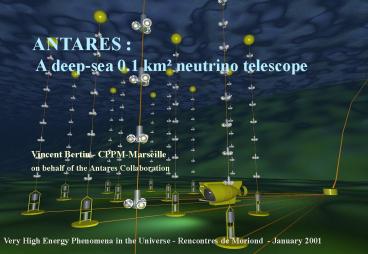Ecole D - PowerPoint PPT Presentation
Title:
Ecole D
Description:
... deployment test at 2300m depth performed with Dynamical Positioning ship ... equipped with 7 PMTs acoustic positioning system linked to shore station by ... – PowerPoint PPT presentation
Number of Views:30
Avg rating:3.0/5.0
Title: Ecole D
1
ANTARES A deep-sea 0.1 km² neutrino telescope
Vincent Bertin - CPPM-Marseille on behalf of the
Antares Collaboration
Very High Energy Phenomena in the Universe -
Rencontres de Moriond - January 2001
2
The ANTARES Collaboration
- University of Oxford
- University of Sheffield
- CPPM, Marseille (IN2P3)
- DSM/DAPNIA, Saclay (CEA)
- IReS, Strasbourg
- Univ. of H.-A., Mulhouse
- C.O.M. Marseille
- IFREMER, Marseille/Brest
- IGRAP (INSU), Provence
- ITEP, Moscow
- University of Bari
- University of Bologna
- University of Catania
- LNS Catania
- University of Rome
- University of Genova
- IFIC, Valencia
- NIKHEF, Amsterdam
3
Detection Principle
Lattice of Photomultipliers Optical Modules
Muon track direction from arrival time of
light Neutrino direction ? ??? ??? ? ? 0.7o /
E0.6(TeV) Muon energy from energy loss and
range
Cherenkov light cone
muon
ANTARESDetector
interaction
A 1km3 detector should record 200 to 2000 high
energy cosmic neutrinos per year (En gt 10-100
TeV).
neutrino
4
Phase I Water properties measurements
- Perform precise measurements of crucial
environmental parameters - In situ measurements on Antares site (2400 m
depth off French Mediterranean coast) - Long term measurements of optical background
(40K decays, bioluminescence) and biofouling of
Optical Modules - Measurement of water transparency _at_ 466 nm
Average 40 kHz on a 8 PMT 60
kHz on a 10 PMT
5
ANTARES Phase I Demonstrator
- First line of 350m high equipped with 16 pairs of
Optical Modules - Summer 98 successful deployment test at 2300m
depth performed with Dynamical Positioning ship - December 99-June 00 demonstrator equipped with
7 PMTs acoustic positioning system linked to
shore station by electro-optical cable
- December 98 successful undersea electrical
connection test of detector anchor performed at
2400m depth by IFREMER submarine vehicle Nautile
6
Acoustic positioning system
4 transponders
Y coord. Range 3 (m)
Triangulation allows ? 5 cm accuracy
7
Reconstruction of Atmospheric Muons
- More than 5? 104 coincidences in all 7 PMTs have
been recorded. - Polar angle of down-going muons deduced from
depth vs. time pattern. - Hyperbolic fit (including multimuons).
- 40K filtered out by the reconstruction software
(see boxed hit in example).
Fit with hyperbola
(noise K40)
z (m)
z (m)
Point measured
ct (m)
ct (m)
8
Reconstruction of Atmospheric Muons
Over 50k 7-fold coincidences recorded more
than 1350 reconstructed events per day
D(fit-point) in ns
Angular Distribution
Data
Simulation
Preliminary comparison with simulation of
single and multiple muons
Track angle (o)
Residual (ns)
9
ANTARES Phase II 0.1 km² Detector
10 strings 900 PMTs in totalDetector to be
deployed at ANTARES site by 2002 - 2004
Shore station
Time calibrationLED Beacon
Optical Moduletriplet
2500m
Local electronic
Electro-optic submarine cable 40km
float
60m
To be deployed in Spring 2001
Hydrophone
300m active
Electronics containers
Readout cables
100m
Junction box
anchor
Acoustic beacon
10
0.1 km² Detector Expected performance
- Including effects of reconstruction and
selection, PMT TTS, positioning, timing
calibration accuracy and scattering. - Below 10 TeV angular error is dominated by ?-?
physical angle. - Above 10 TeV angular accuracy is better than
0.4 (reconstruction error).
- ?E /E ? 3 (E ?1 TeV)
- Below E 100 GeV energy estimation via muon
range measurement.
11
ANTARES 0.1 km² Detector Site
- 40 km SE of Toulon, Southern France (42º 50 N,
6º 10 E) - Shore base at La Seyne-sur-Mer (excellent
infrastructure) - 2400 m below sea level
- 3.5? sr of the sky is covered
- 0.5? sr overlap with Amanda
- Galactic Centre surveyed
12
Scientific Programme
--- Energy ---gt
c
c
c
c
c
c
c
c
c
c
c
c
c
c
c
c
c
c
c
c
c
c
c
Low energy Medium Energy
High energy
- Observation of neutrinos from (extra-)galactic
sources such as GRB, AGN, Supernovae remnants,
molecular clouds, etc.
- Search for neutralinos via their
self-annihilation to products containing
neutrinos at the centre of the Earth, Sun and
Galaxy
- Neutrino oscillations via the modification in the
energy spectrum due to observation of the first
oscillation minimum
13
Conclusions
- ANTARES has made excellent progress over the past
4 years - Site environmental characterisation
OK - Tests of marine technologies
under control - Deployment and operation of Demonstrator String
- First down-going muons reconstructed
- Expanding Collaboration
ANTARES is well engaged in Phase II of its
programme by the design, the installation and
the running of a 10-strings 0.1 km² detector in
2002-2004 Major step forward towards a km-scale
neutrino telescope in the Mediterranean Sea































